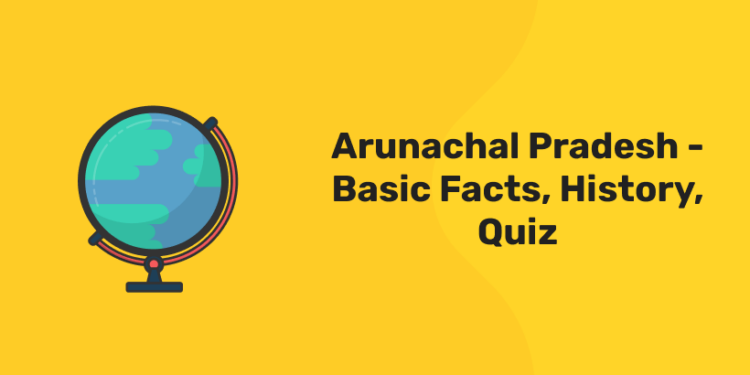Table of Contents
Arunachal Pradesh is a state in north-eastern India with an area of 83,743 square kilometres and a lengthy international border with Bhutan to the west (160 kilometres), China to the north and north-east (1,080 kilometres), and Myanmar to the east (440 km). It ranges from the north’s snow-capped mountains to the south’s Brahmaputra valley plains. Arunachal Pradesh is the largest state in the north-eastern region by area, even greater than Assam, the most populous state.It’s a land of rich green forests, deep river valleys, and lovely plateaus. The area is largely mountainous, with Himalayan mountains extending north-south and mountain ranges crisscrossing the northern boundary.
On February 20, 1987, Arunachal Pradesh became a full-fledged state. It was known as the North-East Frontier Agency until 1972. (NEFA). On January 20, 1972, it became a Union Territory and was renamed Arunachal Pradesh.The first Council of Ministers took office on August 15, 1975, after an elected Legislative Assembly was formed. In February 1978, the first general election for the Assembly was held. The state is divided into sixteen administrative districts. Itanagar, in the Papum Pare district, is the state capital. Itanagar is named after the Ita fort, which was established in the 14th century AD and means “brick fort.”
Arunachal Pradesh: History
The British Indian government signed agreements with the indigenous peoples of northeastern India’s Himalayas in 1912–13 to establish the Balipara border tract in the west, the Sadiya frontier tract in the east, and the Abor and Mishmi hills, as well as the Tirap frontier tract in the south. The North East Frontier Agency, which is now Arunachal Pradesh, was formed by combining these territories. The McMahon Line, about 550 miles (885 kilometres) long and a long-standing subject of contention between India and China, was established at that time as the northern boundary of the territory (now of the state).
Sir Henry McMahon, secretary in the Indian foreign department and envoy of the United Kingdom at the conference held at Simla (now Shimla, in the state of Himachal Pradesh) in 1912–13 to settle border and other concerns connected to Tibet, is named after the boundary. The line served as a geological, ethnic, and administrative divide between the two territories for the British, and representatives from the United Kingdom, China, and Tibet agreed that the border between Tibet and northeastern India should actually follow the top of the high Himalayas. The Chinese republican government, on the other hand, disavowed its delegate two days later and refused to sign the convention.
China claimed virtually the whole upland area of what was then Assam state after India’s independence in 1947, claiming that the McMahon Line had never been recognised by China and was the result of British aggression. The Chinese prime minister, Zhou Enlai, used a map from the 1929 edition of Encyclopedia Britannica depicting the disputed territory as Chinese, with the boundary following the alignment of Chinese maps, in letters to Indian Prime Minister Jawaharlal Nehru. Before 1935, certain Chinese maps depicted the North East Frontier Agency (Arunachal Pradesh) as part of India, but it has since become part of Tibet. The contested tribal lands were depicted as de facto ruled by British India in the Survey of India (1883).Since 1914, the McMahon Line has been followed by British and Indian maps. If the Chinese claims are accepted, the Indian-Chinese border will roughly follow the edge of the Assam plain, creating a barrier that is nearly hard to defend. On August 26, 1959, Chinese troops crossed the McMahon Boundary and took an Indian outpost at Longju, a little distance south of the line, as a result of the dispute. They left the station in 1961, but crossed the border again in October 1962, this time in force.The Chinese launched an offensive along the entire border after first striking the Tanglha ridge and Tawang near the Bhutanese border. At a number of points, significant progress was accomplished. Later, the Chinese decided to withdraw to the McMahon Line, and Indian troops who had been kept as prisoners of war were repatriated to India in 1963.
Since then, efforts to fully integrate the region into India have been made, first with its recognition as a union territory in 1972 and then as a state 15 years later. Though modest, economic progress has been made, particularly with the development of some of the state’s immense hydroelectric potential. Roads have been extended into some rural locations, the state’s first rail line has been built, and tribal villages now have access to electricity, potable water, and telecommunications services. Environmentalists and others who want to conserve the natural landscape have expressed concern about some of these attempts.
Attempt Free GK Mock Test! Download Entri App!
Arunachal Pradesh: Basic Facts
- On January 20, 1972, NEFA was renamed Arunachal Pradesh.
- ‘Land of the dawn-lit mountains,’ Arunachal Pradesh signifies.
- Arunachal Pradesh is the largest of the Northeast’s seven sisters states.
- All domestic tourists must get an Inner Line Permit (ILP) in order to enter Arunachal Pradesh.
- Arunachal Pradesh has the most diverse mammalian population in India, with over 200 species.
- The Hornbill (State Bird), Foxtail Orchid (State Flower), Gayal (State Animal), and Hollong (State Animal) are the state symbols of Arunachal Pradesh (State Tree)
- The state has a total of 1630 kilometres of international border with its neighbours: 1030 kilometres with China, 160 kilometres with Bhutan, and 440 kilometres with Myammar.
- In the Indian subcontinent, Arunachal has the most regional languages.
- The state was previously divided into 17 districts, but in 2013, four more districts were added, bringing the total to 21.
- The 400-year-old Tawang Monastry in Arunachal Pradesh is India’s largest and the world’s second oldest monastry.
- In Arunachal Pradesh, Neolithic implements dating back 11,000 years have been discovered.
- There are 26 major tribes and approximately 100 sub-tribes in the state.
- It has a diverse climate that spans from subtropical in the south to Alpine in the north.
Arunachal Pradesh: Quiz
Q.1.In Arunachal Pradesh, which union minister launched the RIWATCH Museum?
[A] Nitin Gadkari [B] Ashok Gajapathi Raju [C] Kiren Rijiju [D] Prakash JavadekarAnswer: [C] Kiren Rijiju
Q.2.In the state assembly of Nagaland, Meghalaya, Mizoram, and Arunachal Pradesh, which of the following Constitution Amendment Acts provided for the reservation of seats for scheduled tribes?
[A] 52nd [B] 57th [C] 61st [D] 65thAnswer: [B] 57th
Q.3.The Union Cabinet has authorised the submission of a bill to amend Arunachal Pradesh’s Scheduled Tribes (ST) list. Which of the tribes listed below will be on the list?
[A] Mishmi-Kaman [B] Idu [C] Taraon [D] All of the aboveAnswer: [D] All of the above
Q.4.Vijaynagar, India’s easternmost village, is located in which district of Arunachal Pradesh?
[A] Upper Siang
[B] Changlang [C] Lohit [D] East KamengAnswer: [B] Changlang
Q.5.What is the name of the first Hindi newspaper to be published in Arunachal Pradesh?
[A] Pradesh Bhasha [B] Arun Bhoomi [C] Hind Sahitya [D] Hindi TimesAnswer. [B] Arun Bhoomi
Q.6.Mizoram and Arunachal Pradesh were granted Indian statehood in which year?
[A] 1972 [B] 1977 [C] 1982 [D] 1987Answer: [D] 1987
Q.7.When the Sun rises at 5.00 a.m. (IST) in Tirap, Arunachal Pradesh, when will it rise in Kandla, Gujarat?
[A] About 5.00 a.m. [B] About 6.20 a.m. [C] About 7.30 a.m. [D] About 7.00 a.m.Answer: [D] About 7.00 a.m.
Q.8.Which of the following has been designated as Arunachal Pradesh’s new district?
[A] Lepa Rada [B] Pakke-Kessang [C] Manigong [D] Shi YomiAnswer: [D] Shi Yomi
Q 9.Which Arunachal Pradesh tribe celebrates the 52nd Boori Boot Yollo festival in 2019?
[A] Singhpo [B] Mishmi [C] Nyishi [D] ApataniAnswer: [C] Nyishi
Q.10.When did the North-East Frontier Agency become an Arunachal Pradesh Union Territory?
[A] 1950 [B] 1952 [C] 1956 [D] 1972Answer: [D] 1972














